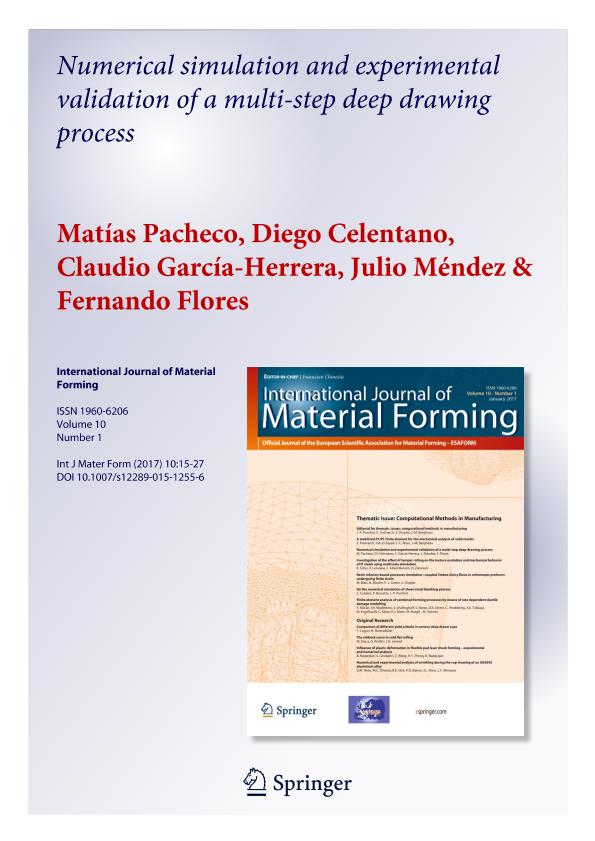Mostrar el registro sencillo del ítem
dc.contributor.author
Pacheco, Matías
dc.contributor.author
Celentano, Diego
dc.contributor.author
García Herrera, Claudio
dc.contributor.author
Méndez, Julio
dc.contributor.author
Flores, Fernando Gabriel

dc.date.available
2020-03-13T22:56:37Z
dc.date.issued
2017-03
dc.identifier.citation
Pacheco, Matías; Celentano, Diego; García Herrera, Claudio; Méndez, Julio; Flores, Fernando Gabriel; Numerical simulation and experimental validation of a multi-step deep drawing process; Springer-Verlag France; International Journal of Material Forming; 10; 1; 3-2017; 15-27
dc.identifier.issn
1960-6206
dc.identifier.uri
http://hdl.handle.net/11336/99622
dc.description.abstract
This paper presents the numerical simulation of an industrial multi-step deep drawing process. A large strain finite element formulation including a hyperelastic elastoplastic constitutive model and a contact-friction law is used to this end where the steel sheet material parameters considered in the analysis are previously derived through a characterization procedure of its mechanical response. The numerical predictions of the final shape and thickness distribution of the blank are compared and discussed with available experimental values measured at the end of three successive drawing steps. In addition, a plastic work-based damage index is used to assess failure occurrence during the process. The damage values computed at the end of the drawing process are found to be lower than that corresponding to rupture in the tensile test, considered here as the threshold of failure, confirming, as observed experimentally, that neither fracture nor necking is developed in the blank during the whole drawing process. Finally, the possibility to carry out a reduced two-step drawing process, obtained by merging the second and third steps of the three-step process, is precluded since the damage criterion predicts in this case excessively large values that indicate that failure may occur in specific zones of the sheet.
dc.format
application/pdf
dc.language.iso
eng
dc.publisher
Springer-Verlag France
dc.rights
info:eu-repo/semantics/openAccess
dc.rights.uri
https://creativecommons.org/licenses/by-nc-sa/2.5/ar/
dc.subject
DAMAGE ESTIMATION
dc.subject
MATERIAL CHARACTERIZATION
dc.subject
MULTI-STEP DEEP DRAWING
dc.subject
SIMULATION OF INDUSTRIAL PROBLEMS
dc.subject.classification
Mecánica Aplicada

dc.subject.classification
Ingeniería Mecánica

dc.subject.classification
INGENIERÍAS Y TECNOLOGÍAS

dc.title
Numerical simulation and experimental validation of a multi-step deep drawing process
dc.type
info:eu-repo/semantics/article
dc.type
info:ar-repo/semantics/artículo
dc.type
info:eu-repo/semantics/publishedVersion
dc.date.updated
2020-02-12T17:52:20Z
dc.identifier.eissn
1960-6214
dc.journal.volume
10
dc.journal.number
1
dc.journal.pagination
15-27
dc.journal.pais
Francia

dc.journal.ciudad
París
dc.description.fil
Fil: Pacheco, Matías. Universidad de Santiago de Chile; Chile
dc.description.fil
Fil: Celentano, Diego. Universidad de Santiago de Chile; Chile
dc.description.fil
Fil: García Herrera, Claudio. Universidad de Santiago de Chile; Chile
dc.description.fil
Fil: Méndez, Julio. Universidad de Santiago de Chile; Chile
dc.description.fil
Fil: Flores, Fernando Gabriel. Consejo Nacional de Investigaciones Científicas y Técnicas. Centro Científico Tecnológico Conicet - Córdoba. Instituto de Estudios Avanzados en Ingeniería y Tecnología. Universidad Nacional de Córdoba. Facultad de Ciencias Exactas Físicas y Naturales. Instituto de Estudios Avanzados en Ingeniería y Tecnología; Argentina. Universidad Nacional de Córdoba. Facultad de Ciencias Exactas Físicas y Naturales. Departamento de Estructuras; Argentina
dc.journal.title
International Journal of Material Forming
dc.relation.alternativeid
info:eu-repo/semantics/altIdentifier/doi/http://dx.doi.org/10.1007/s12289-015-1255-6
dc.relation.alternativeid
info:eu-repo/semantics/altIdentifier/url/https://link.springer.com/article/10.1007%2Fs12289-015-1255-6
Archivos asociados
